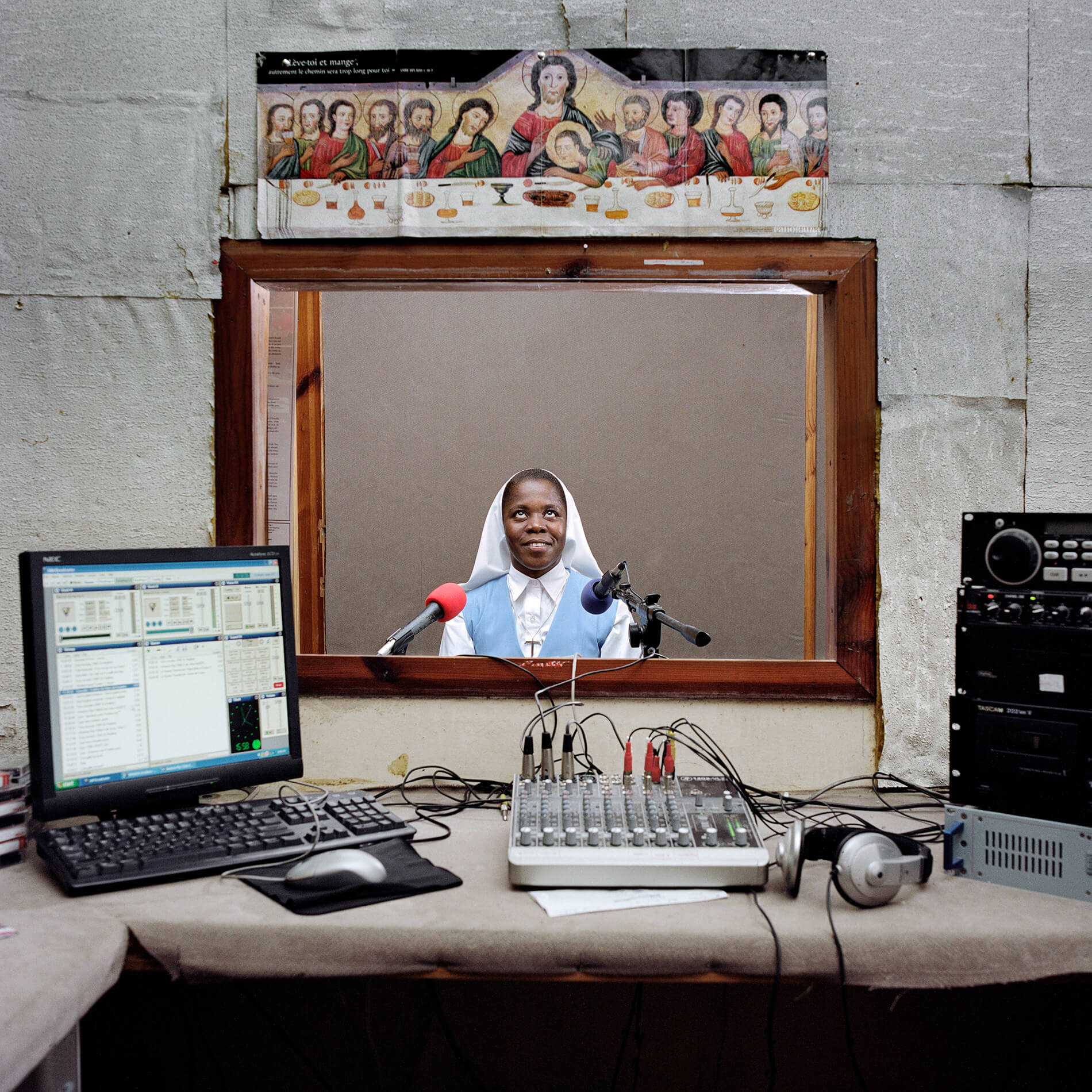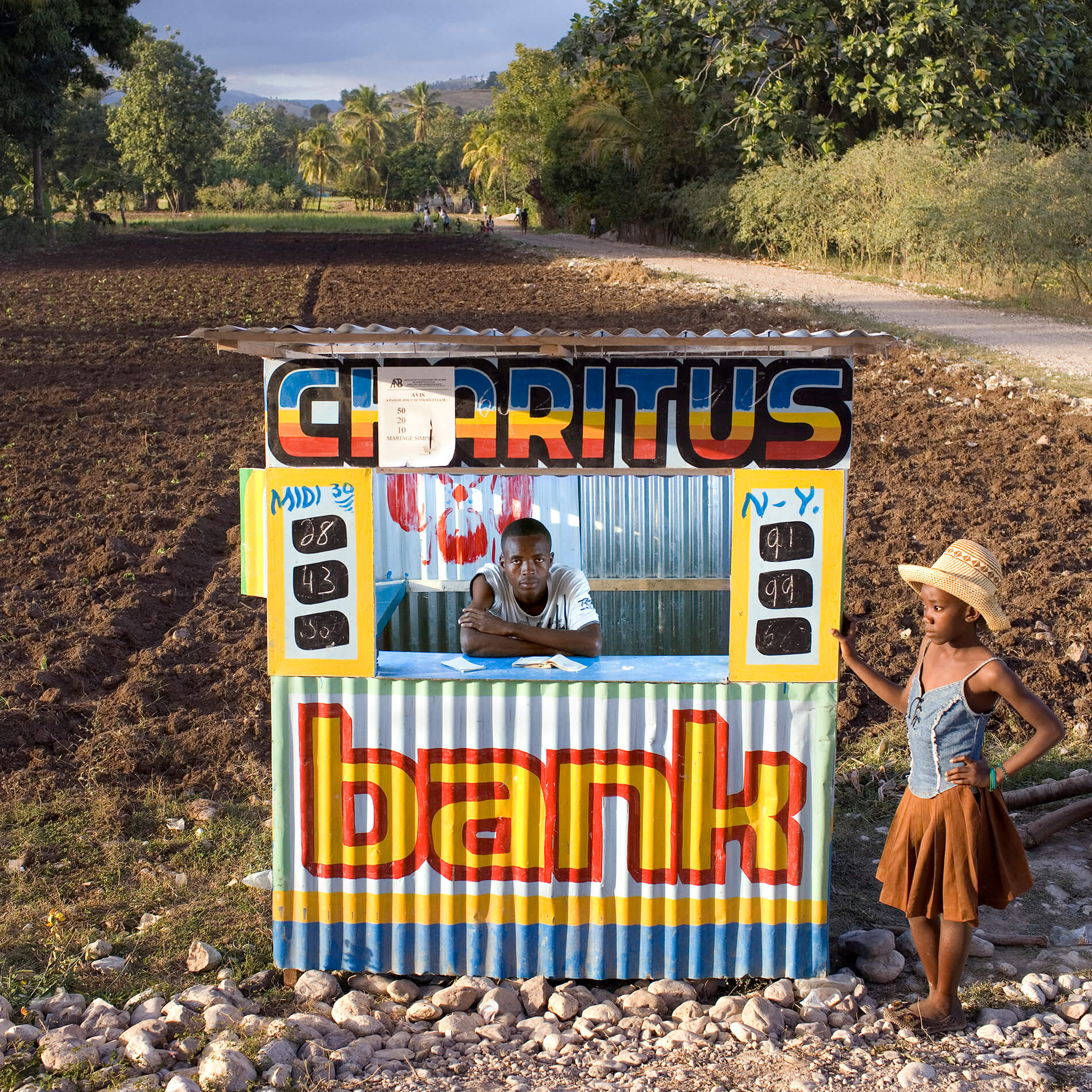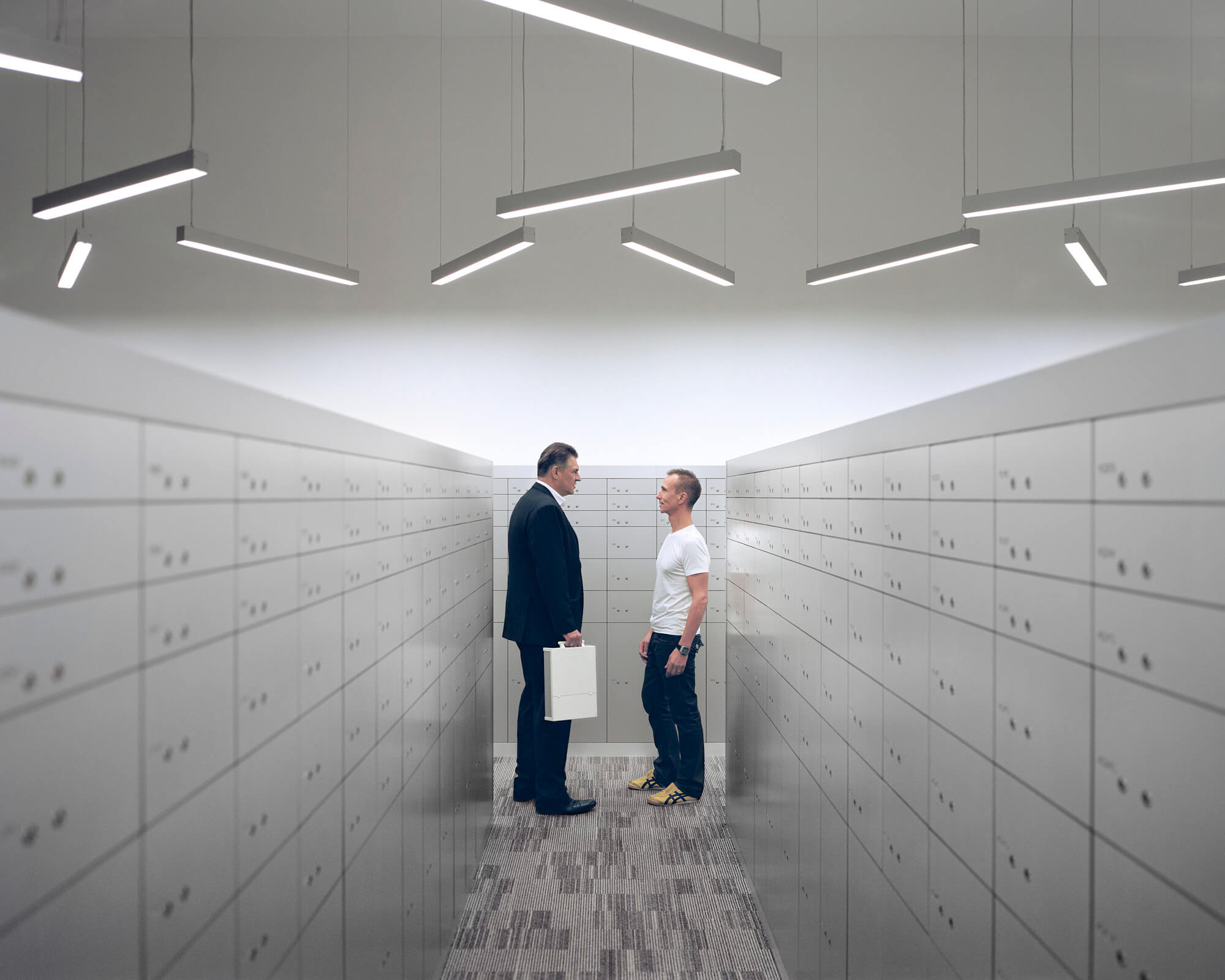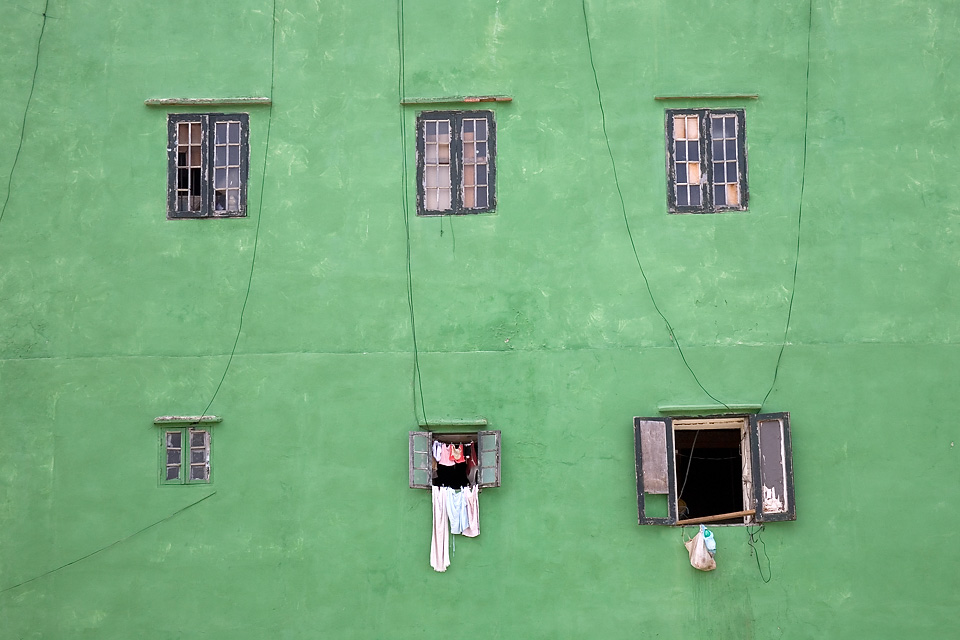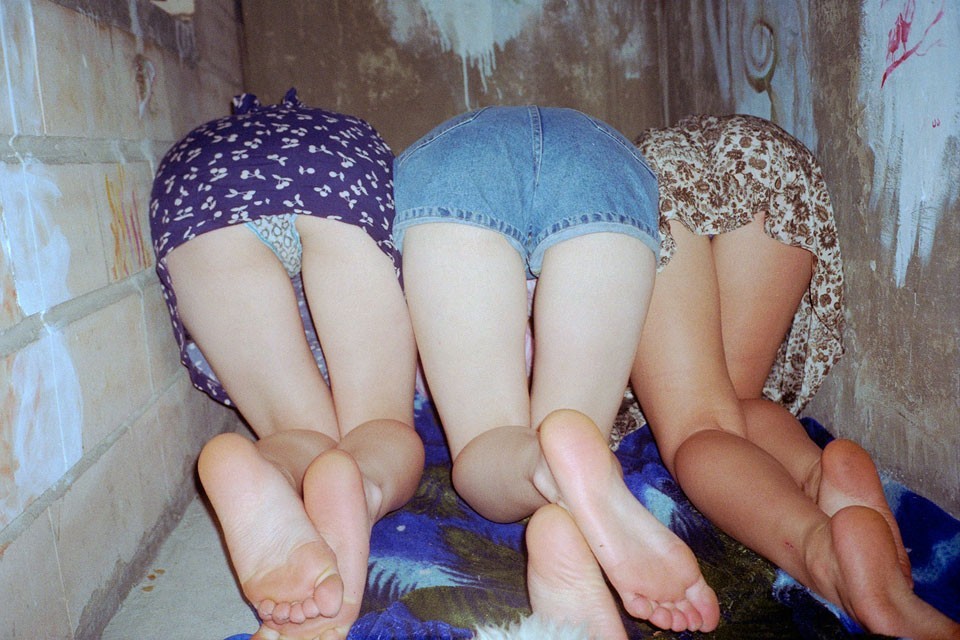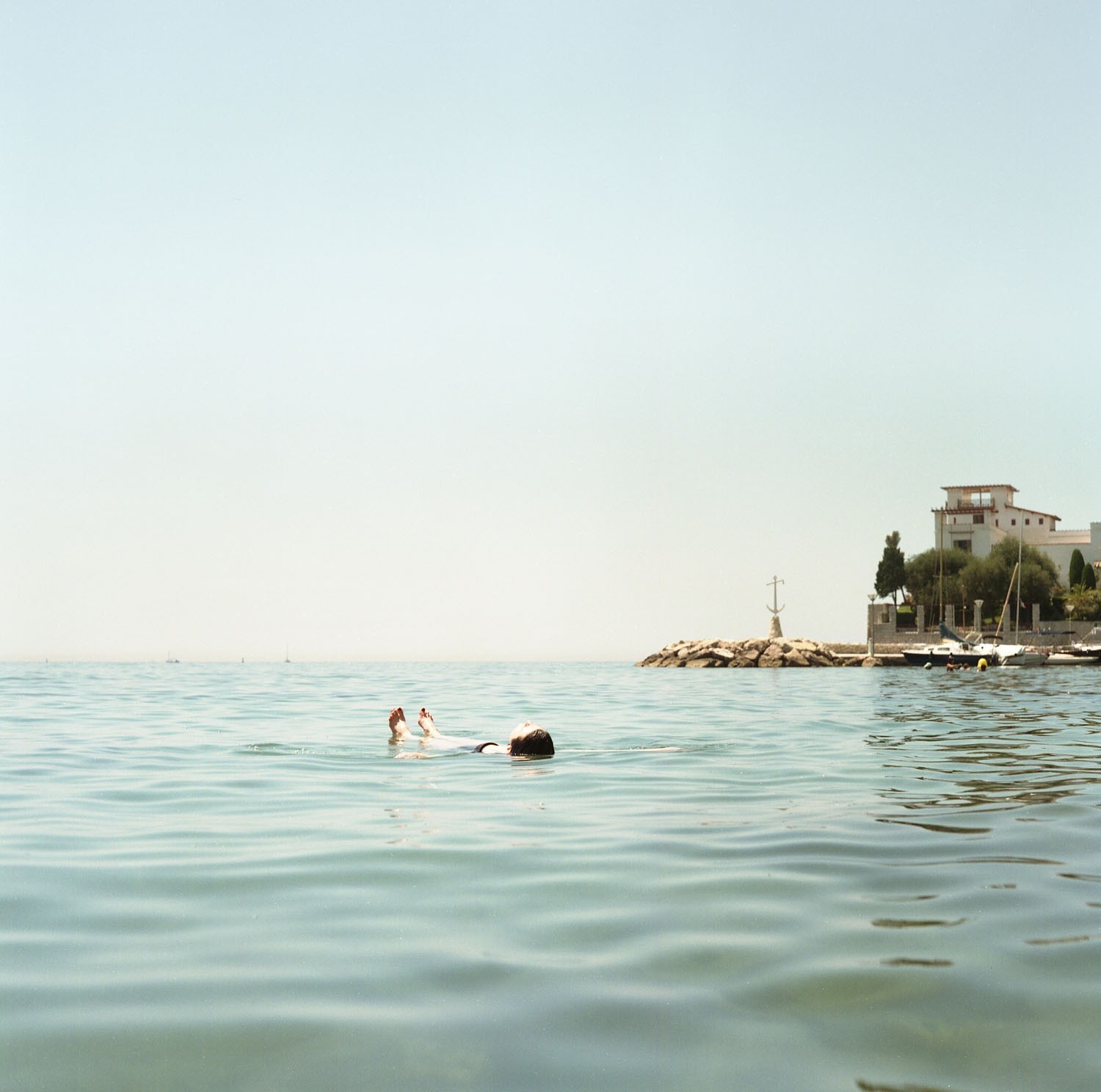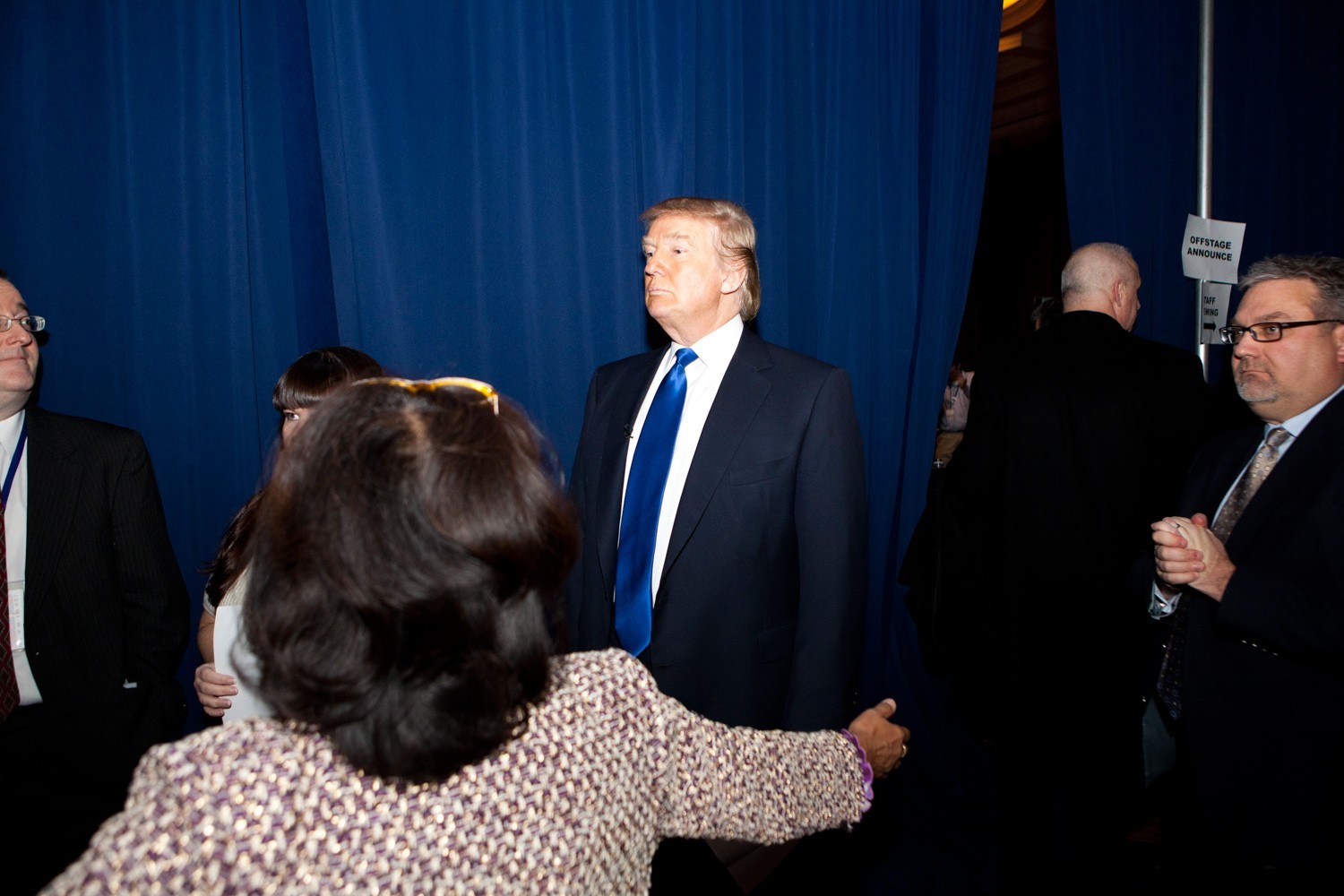10 Favorite Photographs by Paolo Woods, Bird in Flight Prize ‘21 Jury Member
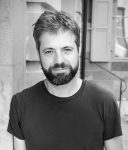
A Dutch–Canadian photographer, filmmaker, curator, and co-founder of the artistic collective Riverboom, Paolo travels the world extensively for his in-depth stories. He published books on oil networks, Iran, Chinese in Africa, Haiti, tax havens, and more. His research is regularly published worldwide in magazines, such as National Geographic, Time, Le Monde, Geo, Internazionale, Newsweek, etc. His work has been shown in solo exhibitions in France, the United States, Germany, Switzerland, China, Haiti, Italy, Belgium, the Netherlands, Spain, and numerous group shows around the world. Bird in Flight Prize '21 Jury member.
1
The first image is from a pretty long ago when I worked in the black and white square format; I practiced photojournalism but in an unusual manner. It was the time when digital cameras were on the rise and what I did was go backward instead to even a slower format. Square 6×6 on film. What was happening was this obsession with the speed: you took a photo, you sent it to a newspaper or a magazine, and they would put it on the internet – and it lasted a few days or maybe a few hours. I wanted to understand the wars in Afghanistan and Iraq – it was a part of my project, “American Chaos.” And it was about the American-led wars, in Afghanistan and Iraq, two wars led by Bush. So I fought for a more in-depth investigated journalism than something more superficial. I traveled extensively in both countries.
The Afghans celebrating the fact that the Taliban had left were the Shia Afghans – not from the same religious background as the Taliban, who are Sunni. They were heavily repressed during the Taliban regime. Here they celebrate a traditional Afghan Shia festivity, which was forbidden to celebrate when the Taliban were in power. So it resonates particularly now with what is happening in Afghanistan. I imagine that maybe now the children of these men are experiencing what these man had experienced for years of the Taliban rule in Kabul.
So this belongs more to the photojournalistic period, that kind of approach, but also very careful of composition and image strength. During that time, I was already a big believer in collaboration between the image and the word, so naturally I worked with journalists. Almost all my projects are collaboration projects: with the photographer Gabriele Galimberti and the journalists Serge Michel and Arnaud Robert. And that’s also why I’ve had a hard time selecting a few images: images are always part of a project, of a more extensive story where images are bricks in larger construction, which is the narrative.
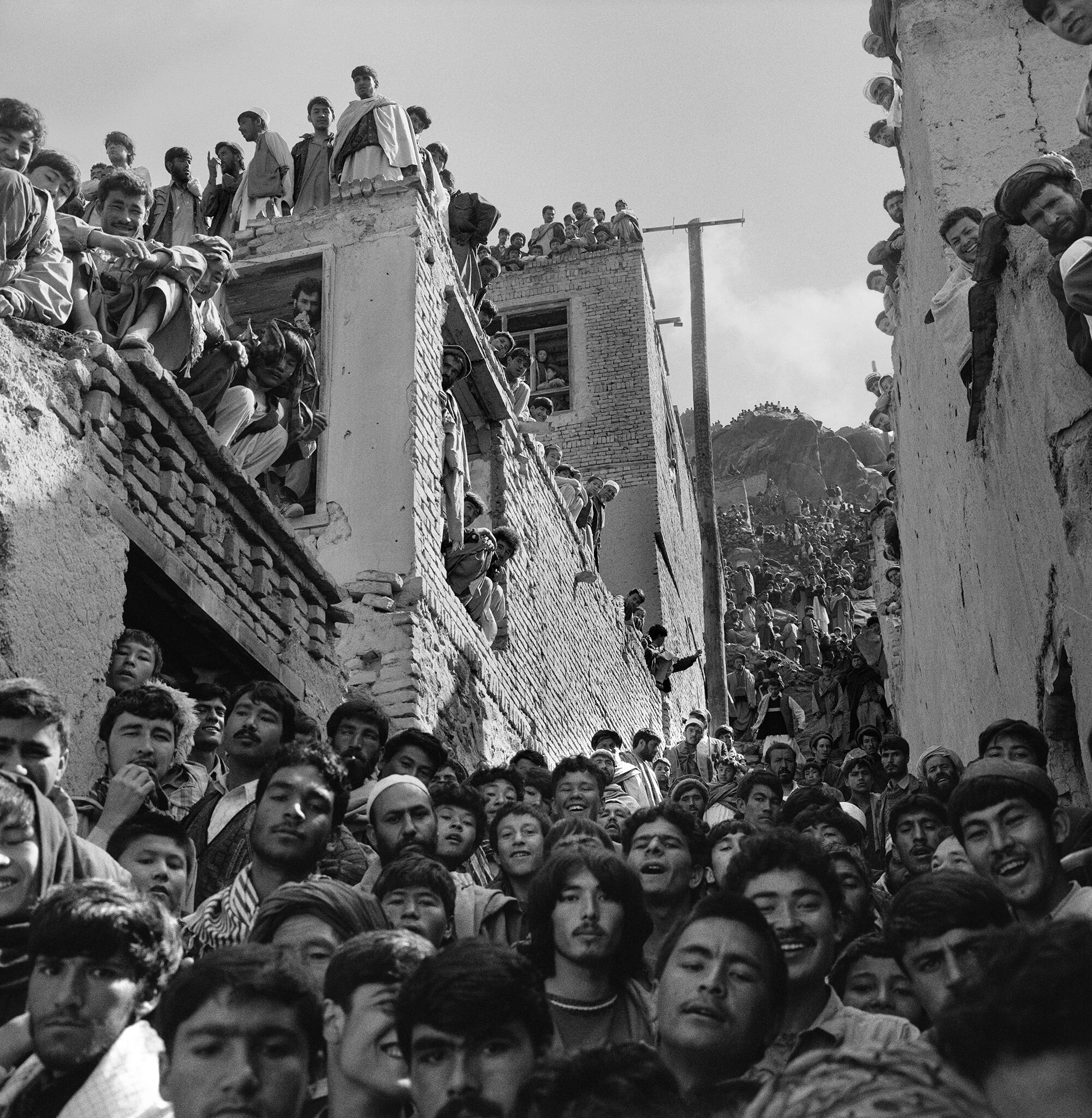
2
The second image is an image made in Iraq, it’s also part of the American Chaos project. This is when I went into the more classic photojournalism – again, I would say, with real attention to the photographic language but using the tropes of classic photojournalism. The in-your-face image is about Iraqis who are using equipment they have taken from the Americans.
This is the Sunni uprising in Iraq which eventually brought to the civil war in Iraq, which was caused by the American removal of Saddam Hussein.
I was moving away from photos that were exclamation marks to photos that are question marks which I think is more interesting.
For me, it also coincided with the time when I started rethinking the whole clichés of photojournalism. You know, the “if your photo is not good enough, you are not close enough” kind of rhetoric. But also the kind of language – obviously, black and white but also the assumption that a photograph has to be “spectacular” – you have to see the image and go “oh my god, wow”. So I was moving away from photos that were exclamation marks to photos that are question marks which I think is more interesting.
I started working in Iran after working in Iraq and Afghanistan, and Iran is geographically between Afghanistan and Iraq. That’s where I met Serge Michel, the journalist with whom I worked together on eight different books. I was going to Iran with a series of images on my mind, and I was going to reproduce those images. I think it’s something pretty much embedded in photojournalism where you reproduce the same kind of language in different contexts. And Iran is a place that has been enormously stereotyped by the West. And when I came to Iran, I started looking for images that I imagined I should have done, but I quickly realized that these images, even though they exist there, were a very small part of what you see in that country. And that country was a lot larger, a lot more complex and layered than the very shallow image of, you know, the bearded guy with a Kalashnikov. So I started changing the approach, changing the narrative, the language, the tool. I started taking pictures in color because it was one of the most colorful places in the world: exaggerated, intense colors, which made it even more interesting for me.
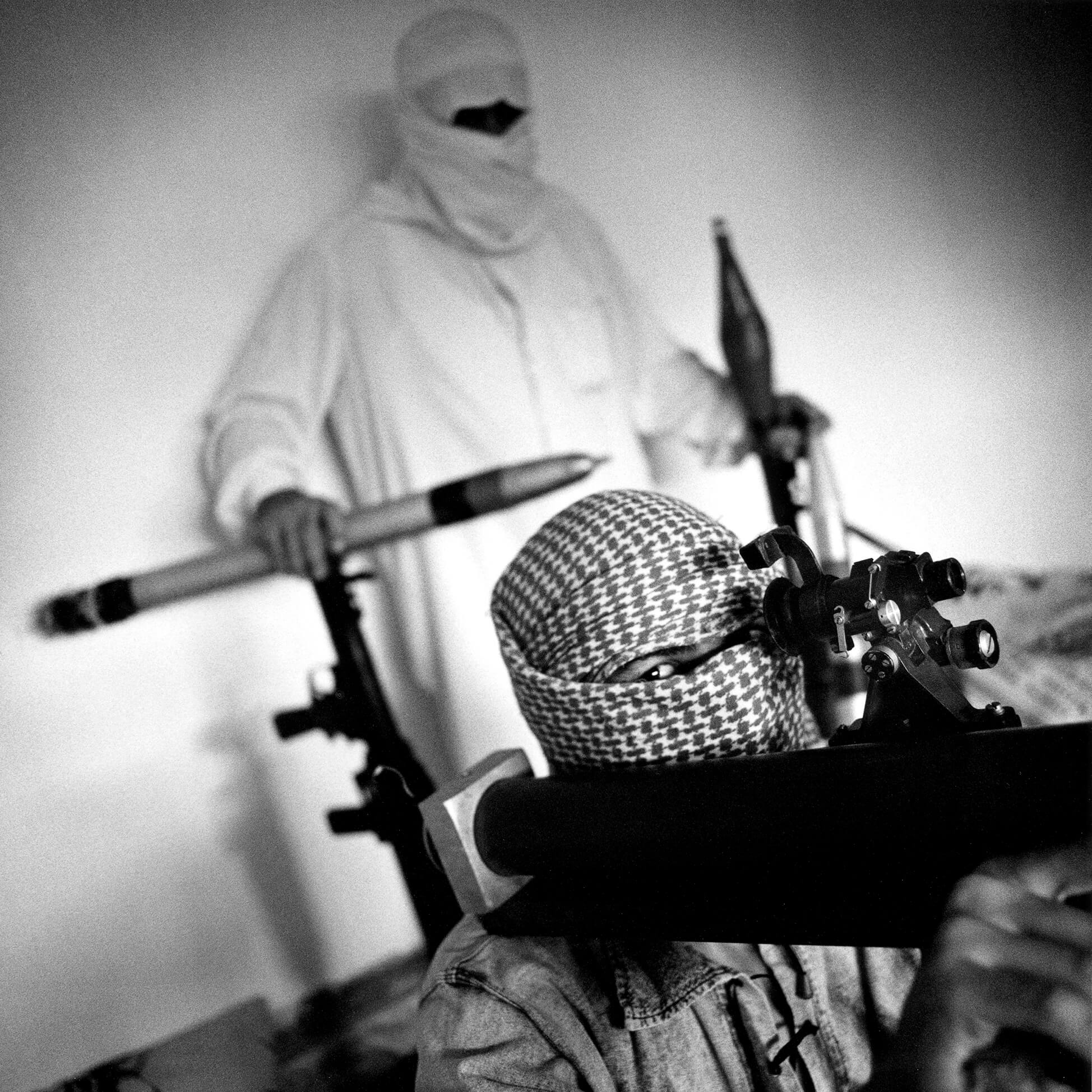
3
Here we are in the project called Chinafrica, which is a significant breakthrough project for me. I mean, I had already done two acclaimed books and won a WorldPressPhoto Award for images made in Iraq, but what changed things for me was the Chinafrica project because it was a phenomenon that wasn’t known at that time. There were no main press articles and only a few academic papers about the thousands of Chinese coming to Africa and investing in it. There was very little general news about this phenomenon, which is actually changing the shape of Africa.
So Serge and I decided to do a story about this. And quickly, I realized that there was nothing to photograph (laughing). You know, it wasn’t spectacular, it wasn’t like war, it wasn’t exciting. First of all, the Chinese didn’t want to give you any access. It was easier to photograph war than to photograph the Chinese in Africa. So I had to invent a different language.
I played with two kinds of languages: the colonial photography, from the turn of the century – you know, the Belgian, French, and British photographers in Africa documenting their vision of Africa and, as well, the revolutionary photography in China – Mao Zedong years of glorifying photography, of looking at the fields and blessing tractors – the conquests of Chinese communism.
So, the photograph number three shows a successful Chinese entrepreneur living in Nigeria for a long time. He’d been elected as an African chief (which is like a title), and he had protection directly from the Nigerian government. He was inspecting the house that one of his many companies was constructing for the American company Chevron. And he had a guard going after him with an umbrella offering respite from the sun, and I thought – it so much summarizes what I was trying to tell about the Chinafrica. What was crucial for me – I felt that a photograph like this poses more questions than answers. I also like how this image is multi-layered. Looking at this image, in China, they would say: “Oh look, how successful we are in Africa,” and the Americans would say: “Oh, the yellow danger, they are coming to conquest Africa, they have the new colonial power.” So what the photograph means depends on who looks at it, which is extremely interesting for me.
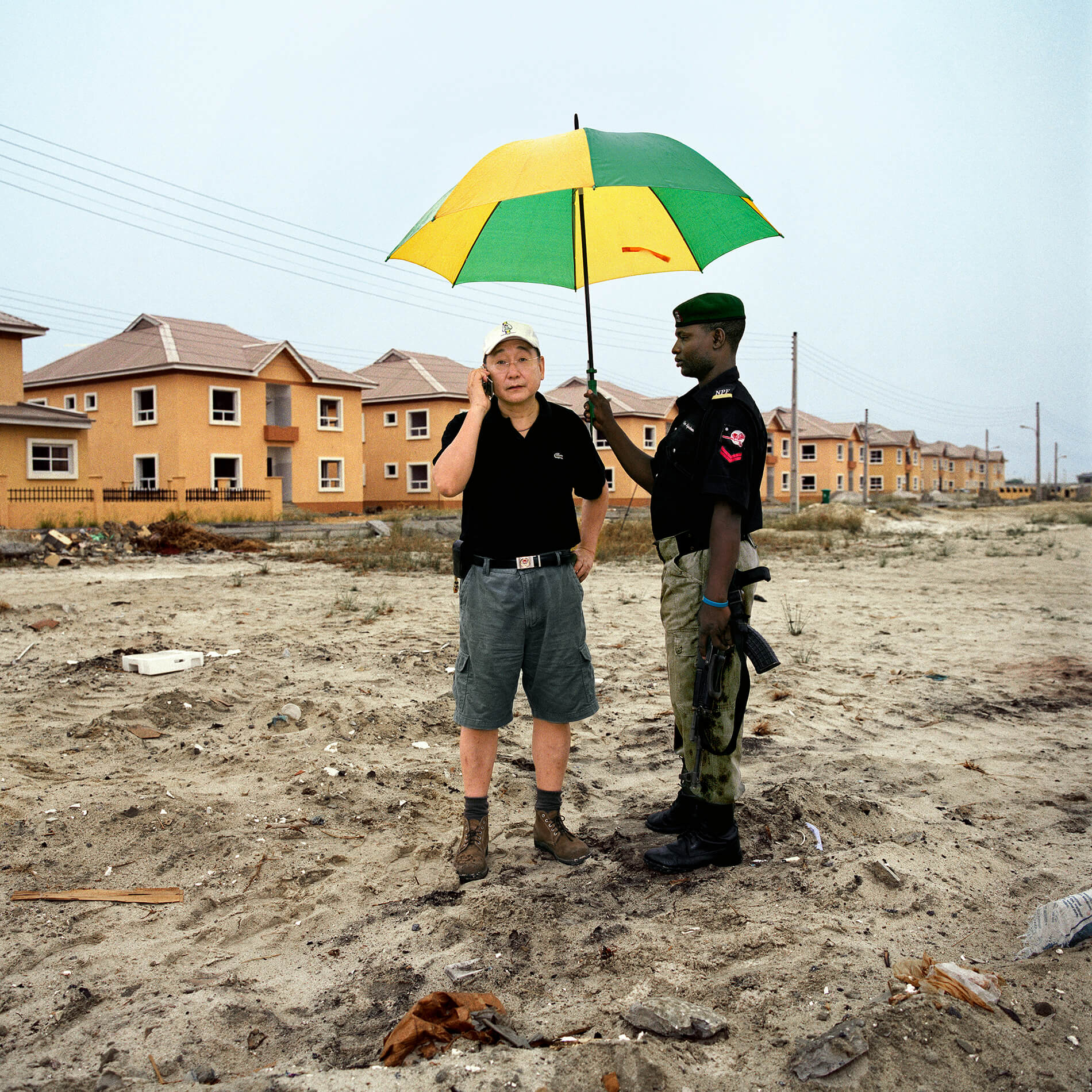
4
Image number four is similar. Working on Chinafrica, I figured out that no, they didn’t speak the same language – actually, they were even condemned to be together. I don’t think I’ve ever seen so much racism as in Chinafrica: from the Chinese towards Africans and Africans towards Chinese. They sincerely hate each other, but they need each other for economic interests. That makes it extremely interesting because the classic colonial narrative is: “Look, how happy we are” – for instance, the Belgian coming to Africa or the revolutionary imagery, which says: “Oh, how magnificent is what the communism is doing for China.”
I was playing with this. Here the gesture reminds you of the postures of Mao Zedong, but he’s basically explaining something to the worker who doesn’t speak the same language, so they need to use gestures. If you look at the details – for example, the shoes of the Chinese guy are protective, and the shoes of the Nigerian guy are just slippers – you get more layers to what has been said here.
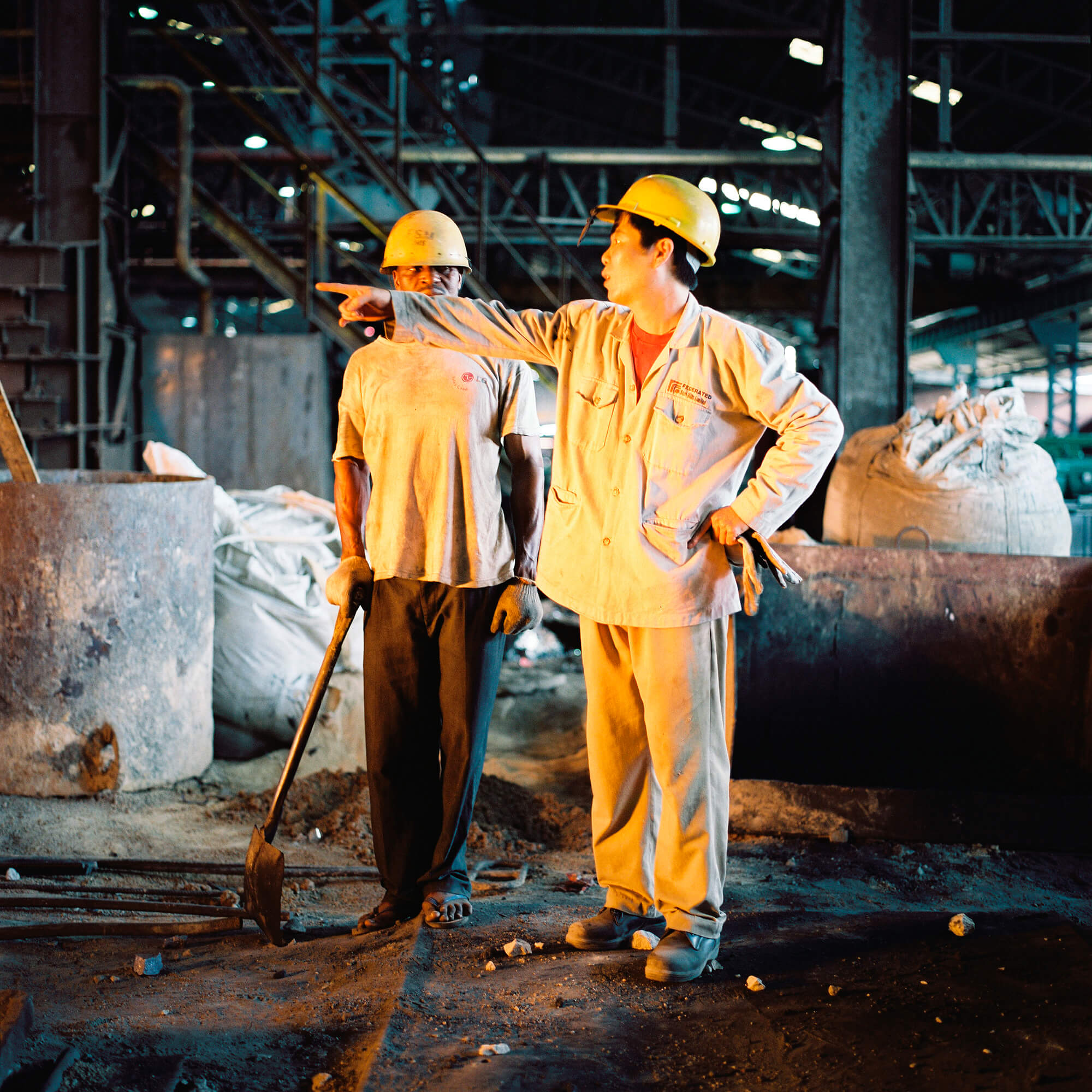
5
Image number five is about Iran. When you think about Iran, one of the first things that come to mind is women’s rights. Obviously, women’s rights in Iran are not the same as in Holland – there’s no discussion about that. But compared to the countries around like Saudi Arabia, Iran has pretty advanced women’s rights.
They told me that it’s a constructed photograph, that no woman could ever be a dentist in Iran.
One of the classic stories about Iran is how women are repressed, and there is no discussion about that, but also, I found it interesting to show how it’s more complex. So this is a lady dentist operating on a man. This image was published in Time magazine, and I got a lot of hate mail from Iranians that escaped from Iran in 1979 during the revolution and are against the Islamic regime in Teheran. They told me that it’s a constructed photograph, that no woman could ever be a dentist in Iran.
So I found it again interesting to kind of go and break the cliches. Serge and I discovered that the Iranian society was so complex that it was difficult to do it one story, so what we did was: we took lots of different people from all walks of society – rich, poor, religious and secular, North and South, women and men, gay and straight – and tried to put them together, like if they were pieces of a puzzle, trying to make a portrait of the complexity of Iranian society.

67
At the time I was living in Paris, getting visas to Iran was extremely complicated. For many years, Serge was not allowed in Iran, so I did a lot of stories on my own. So I went to Haiti, I was supposed to be there for six months, but I stayed for four years. I started working with another journalist, Arnaud Robert. He had ten years of experience on Haiti.
Haiti is famously one of the world’s poorest countries, you know, and photo agencies’ archives are full of photos of misery in Haiti. I didn’t want to play with that; I wanted to play with how society deals with the fact that there is no state, how it reorganizes along different lines, how the impossible desire for a working state has shaped this country and why it is a living social laboratory. This is even more true now that the president has recently been assassinated in Haiti.
One of the first things that people tell you about Haiti is that it’s a failed state. The state is not there, and all kinds of things come to take its place. For example, Haitians play the lottery and do not use banks, and this makes sense – the system is so badly structured that if you put money in the lottery, you have more chances of making some money than if you put money in a bank.
So people play the lottery; they even call it “The Bank.” Whenever you go in Haiti, lotteries exist, and it’s a highly organized and working system. Even if you are in an area where there is no phone signal, no electricity, up in the mountains – even there, this lottery thing works, and it works perfectly. So in Haiti, I focused on what was working and why instead of dwelling in “poornography.”
I was living in Les Cayes, situated in the south of Haiti; it’s a small town, just over fifty thousand people. In Les Cayes, almost half of the population is illiterate, so they can not read newspapers. Very few people have enough money and electricity to afford a television, but everybody has radios. So in this small town, there are at least fifteen different radio stations, they are cheap to set up, and basically, they represent all the different kinds of society: there are religious radio stations, voudou radio stations, American-backed radio stations, left-wing radio stations, football radio stations, political radio stations, etc. They are a perfect mirror of society. I did a series of portraits within the radio stations, and I liked it because there is nothing to photograph in the radio stations, and when there is nothing to photograph, you start thinking.
89
This is another big project on which I spent at least a couple of years. I made it with Gabriele Galiberti. I am not an economist, but if I were born again, I would study the economy. Understanding what tax havens are and what they represent was extremely interesting.
I thought that tax havens were a James Bond kind of thing of people with suitcases full of money. But actually, they are engrained in the financial system; they are at the core of the financial system: Amazon wouldn’t work without tax havens, Apple couldn’t function without tax heavens, Chiquita that sells bananas wouldn’t work without tax havens. Tax havens are at the base of how our finance works today, often in a legal manner. As one guy put it, “it is legal, but it is not moral.”
But this doesn’t mean that tax havens are some sort of a mafia thing: obviously, mafias use tax havens, but who uses tax havens most is Amazon, you know, it’s a big company, and they use it legally. These are schemes that allow them to pay very little taxes compared to, for instance, a local library in Amsterdam: they have to pay a lot of taxes, and there is no way they could use a tax haven. So there we started implying a kind of slick images of banks, and here we are in the free port of Singapore, which is one of the most incredible places for tax havens; this imagery wants to reproduce a kind of James Bond thing, while actually we’re speaking about how the finance works.
The two images about tax havens are from Singapore, but here we are at the Infinity Swimming Pool in Singapore overlooking the financial district. This guy is somebody working in tax havens; he was there in Singapore for a symposium run by one of the Big Four accounting companies on how to avoid taxes. This guy was there, having a swim in the morning before one of those big meetings. When you are photographing something like this, you have to employ other languages to bring your story out because there is nothing to see in a tax haven, nothing to photograph, so what you know about tax havens nourishes your imagery. This man is shown floating above everything, not being constrained by the laws of gravity like everybody else. This kind of storytelling was extremely interesting for us.
I always say that my projects last for so long not because I photograph slowly but because there is an enormous amount of research, which brings us to my last project.
10
My last project is called Happy Pills – this has been the longest and the most complex project I’ve ever worked on. It is a project I have done and co-signed with Arnaud Robert. It’s again a book that has just come out; it’s going to be in the bookstores starting next week. A show has just opened at La Ferme des Tilleuls in Switzerland; the story is coming out in different magazines worldwide. But it’s also a film, so it’s the first time I am making a film.
It’s a project that started after Tax Havens – I wanted to do another story on the industry. It is about the pharmaceutical industry. I quickly realized that I was not going to photograph labs all the way, and I am not in investigative journalism, so I was not going to raise a scandal. I just tried to understand and then maybe explain how a system works.
What is fascinating about the pharmaceutical industry is not so much that if you are sick, they give you a pill, and you get better. Much of what they sell is a promise to be better – not just health-wise but also as humans. The narrative is that the very limit we have as humans can be overtaken by chemistry, so actually, it promises happiness. So if you are small, they’ll give you pills to be bigger; if you cannot get it up anymore, they’ll give you viagra to always have an erection. If you are losing your hair, they will promise you something for that; if you are depressed – you have a pill to be happy; if you are tired – you have a pill to go on.
Pills take the place of what religion was before, what philosophy was before.
So the whole idea was not anymore to do a story about the industry, even though the industry comes out in the project a lot. It is about us as consumers and our desire for chemical happiness. The project started with street sellers in Haiti, which is how Haitians get their medicines: through untrained sellers who go around and sell pills without knowing what they are. And these are fake pills, counterfeit, generic, from the Dominican Republic, India, and China – you name it. They got everything there, it’s a chemical bubble, and it’s a tower of promises. People need to want those pills; they need to desire them like if they were candies. This thing on the photograph looks like a magnificent sculpture of promises. People need to want those pills; they need to desire them like if they were candies.
This thing on the photo actually looks like a magnificent sculpture of promises. This is where Star Wars: Il risveglio della Forza.
I started the project from a photographic point of view. And within this project, I employed lots of different kinds of languages; I used people’s Instagram, I used photographs made by phone or by an eight by ten camera, like in this case. So it’s a very wide-reaching project. I’ve spent five years on it – because there was also a film. The film is coming out next year.
The timing of this project coincided with the coronavirus outbreak, and it’s unbelievable; I promise I didn’t plan that. We were editing the film in the Swiss mountains when the lockdown happened, so the whole world stopped. I couldn’t go back to Italy, where my family was. And we thought – maybe we’ll be saved by a vaccine! The vaccine would change how things go. Our relationship with chemistry is incredible.
When we started the project, people were asking: “What are happy pills?” One of the happy pills is the pentobarbital, which is used in Switzerland for assisted suicide. We followed a man that decided to go and die. For him, pentobarbital was a happy pill because it freed him from life. So what is the happy pill? What is your happy pill? When we were in Peru, in that particular area of Peru, a quarter of girls had their first pregnancy before they were eighteen. And you know, the contraception pills finally give them control over their bodies, so it’s a happy pill for them. It’s a complete revolution. In Tel Aviv, we followed a gay man who takes prep (medicine people take to prevent getting HIV). Basically, a few years ago, he was scared every time he had a relationship; now, he takes a pill, and he has a chemical condom around him. So in any situation – there is a pill. Pills take the place of what religion was before, what philosophy was before.
Pills take the place of what religion was before, what philosophy was before.

Paolo Woods by Magali Dougados
Translated by Lubov Borshevsky
New and best
